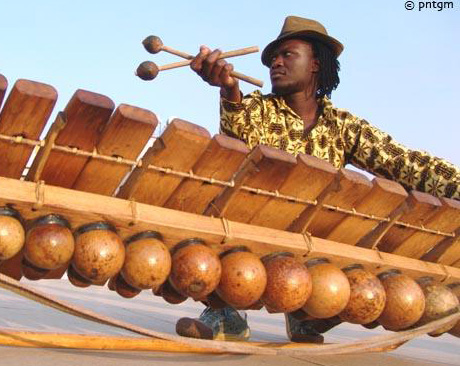

MDG-F helps to preserve Mozambique musical tradition

Cheny Wa Gune can’t remember how old he was when he started playing the xylophone-like instrument known as the Mbila -- it was always “just there” he says, an ever present part of his childhood. Wa Gune is a member of Mozambique’s Chopi tribe and hails from the city of Zavala, home to the Chopi Timbila tradition, a unique cultural expression that was proclaimed a Masterpiece of the Oral and Intangible Heritage of Humanity by UNESCO.
Traditionally, the Mbila is part of an orchestral arrangement made up of many different sizes of the instrument (known together as “Timbila”), but Wa Gune usually plays his Mbila solo with only a backing band, so that the richness and depth of the instrument’s tonality can be fully appreciated. As leader of the Wa Gune quartet, which has just released its first CD, Wa Gune uses the Mbila to interpret various and diverse influences from contemporary music as well as from his life in the city.
“It symbolizes us and identifies us, and maybe it can take us far,” he says of the Timbila and its importance for Mozambican culture.
Today, that tradition is under threat. One of the main materials used in the production of the Timbila is wood from the Mwendje tree, but due to de-forestation and the clearing of trees to make way for cash crops, Mwendje is becoming almost impossible to find in Zavala. Wa Gune laments that Timbila players must now travel long distances to source the wood and incur high costs to bring it back to Zavala – as a result, fewer people are playing the instrument.
Now, a joint UN programme funded by the MDG-F is helping to safeguard the Timbila tradition by establishing community tree nurseries to re-introduce the Mwendje species back to Zavala, and preserve its use for future generations. (Mwendje is a slow growing species, which takes 50-60 years to mature). This activity involves the producers and players of the Timbila in collecting seeds for the propagation of the tree, thus helping to preserve a unique tradition which also acts as a driver for cultural tourism in Zavala.
The programme is working to sensitize the community to the importance of long-term investment in the Mwendje as a culturally important species that can be grown alongside income-generating species, and that in time will provide both cultural and commercial benefits to the area.
For players like Wa Gune, it is a crucial investment: “It needs people with courage to change the situation…It’s our heritage and it should be protected…One day we will regret [losing this tradition].”
“I have a passion for the instrument and in truth I feel a responsibility to give some continuity [to the Timbila] for my generation, to inspire others and introduce them to the joy of the Timbila," says Wa Gune, who himself was inspired and encouraged by his uncle, a Timbila master.
The Joint Programme for Cultural and Creative Industries and Inclusive Policies in Mozambique brings together six UN agencies (UNESCO, ITC, ILO, FAO, UNHCR, UNFPA) and nine Mozambique government ministries.